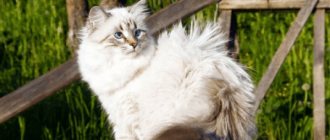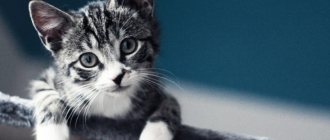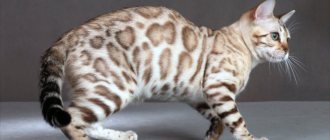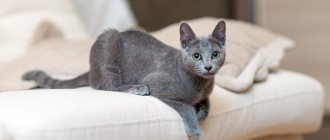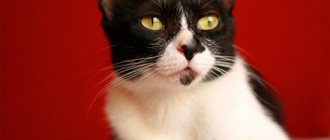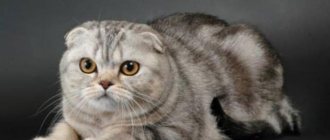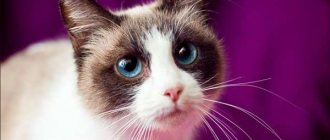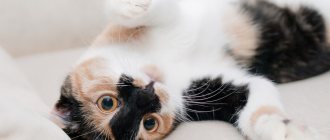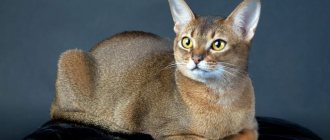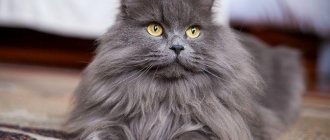Do you dream of a devoted, affectionate and faithful friend?! Welcome to the Snow Angel nursery!
Our monokentery Snow Angel is the only one in Russia and Moscow that has been breeding this unusual breed of Snow Shu cats at the Highest Level for many years.
Nursery Snow Angel is pleased to welcome you to the pages of our website. What is a nursery? In most cases, the breeder is a passionate person who devotes himself entirely to the idea of developing his breed. This person is able to spend a lot of money on his animals and on the development of the nursery, for the sake of constant improvement of the breed's qualities, he is ready to travel the longest trips to bring a new sire, specially studying genetics and veterinary medicine, and bearing the proud name of “felinologist” or “cynologist”. This person is always ready in the future to communicate with those who purchased a pet from him, to give advice and recommendations, this is a person who is not indifferent to the further fate of the animal he sold.
Dear friends, subscribe to our Instagram and stay up to date with all the news in our nursery!
Brief history of the breed
The homeland of cats in snow shoes is the city of Philadelphia in Pennsylvania, USA. It was there that in the 60s of the last century, Siamese breeder Dorothy Hinds-Doherty became interested in unusual kittens with original white markings and pronounced toes.
The woman liked the non-standard color so much that she decided to try to fix it. To achieve her goal, Dorothy bred a Siamese cat with an American Shorthair Bicolor. However, the results of the experiment did not impress the breeder at all. And to improve it, the Siamese cat was re-involved in breeding work.
After felinologists refused to recognize the first snowshoe as an independent breed, Hinds-Doherty stopped breeding them. But her work was continued by another American breeder, Vicki Olander. Her persistence paid off, and the Snowshoe cat breed was eventually standardized.
And in 1974, it was registered by the American Feline Association and the Association of Cat Fanciers as experimental. After 8 years, snowshoes began to be allowed into exhibitions. In 1986, they were included in the British cat breeding program.
Origin story
“Snowshoe (Snow-shu)” translates as “snow shoes.” Beautiful, is not it? And the breed itself is a real work of art. It appeared in the middle of the last century, when breeder Dorothy Haidins-Doherty discovered a wonderful trinity in her next litter of kittens: kittens whose paws seemed to be shod in milky white ballet shoes.
It looked so cute that the owner decided to consolidate the result and began experimenting: mixing the American Shorthair and Siamese breeds. The work went on long and hard, and there were some disappointments. Dougherty was upset by the refusals of large felinological organizations to register the breed and she refused further work.
The abandoned baton was picked up by American Vicky Olander. Even more problems befell her: the breed was recognized, a standard was drawn up, and even allowed to participate in exhibition activities, but for some reasons the Snowshoe found itself on the verge of extinction several times, and only large financial investments and outside help helped to stay afloat.
The only nursery in Russia is located in Moscow. The second option is private breeders (in this case, you should trust only sellers whose reputation can be verified). Kittens should be adopted at the age of 3-4 months: by this time they already have all the main characteristics of the breed, in addition, they already know how to eat independently, go to the toilet and sharpen their claws on a scratching post. Signs of a healthy animal: soft belly, clean and dry eyes, nose and ears, clean bottom, activity and playfulness.
Interesting Facts
Interesting facts about this breed will help you get to know the Snowshoe better:
- These cats got their name from their white paws. Translated from English, Snowshoe means “snow shoe.”
- The unpopularity of the breed is explained by the strict requirements of the color standard. Due to the relative youth of the Snowshoe and the presence of recessive genes, breeding these cats is like Russian roulette. No breeder is able to predict what color the kittens from each subsequent litter will have.
Breed description, standards, appearance
Snowshoes are harmoniously built cats with a beautiful color and white paws. They harmoniously combine the gracefulness of the Siamese and the heaviness of the American Shorthair breed.
The generally accepted Snowshoe standard clearly defines the basic requirements for the appearance of cats and the defects of the exterior. According to this document, representatives of the breed who have:
- tail creases;
- not blue iris;
- incorrect body structure;
- strabismus;
- plush wool;
- bulging eyes;
- not white paws.
Dimensions and weight
The Snowshoe is a medium-sized cat with moderate sexual dimorphism. The weight of the female ranges from 4-4.5 kg. The weight of a male can reach 6 kg.
Anatomical characteristics
A typical Snowshoe cat should fit the following description:
- The head is in the shape of an isosceles triangle, with smooth contours, a strong chin and high cheekbones. The nose is moderately wide, with a soft curve at the bridge of the nose and a small hump. The lobe may be pink or spotted.
- The ears are medium wide, tapering smoothly to rounded tips.
- The eyes are oval-shaped, slightly elongated. Directed slightly towards the base of the ears, not protruding. The Snowshoe's iris is colored in any shade of blue or light blue. The brighter the eyes, the more valuable the cat with snow shoes.
- The body is powerful, proportional, with a fairly long neck and well-developed muscles.
- The limbs are of medium length, with oval paws and strong claws.
- The tail is of normal length, gradually tapering to the tip.
Color and coat type
Snowshoes are short-haired cats with smooth, silky, pleasant-to-touch fur.
The following color options are allowed in the breed:
- seal point;
- blue point;
- tortoiseshell.
The main distinguishing features of a purebred Snowshoe are clearly defined snow-white “socks” on all four paws and a spot on the face in the shape of a “V” with the top at the level of the cat’s eyes.
On a note. Snowshoe kittens are born light colored. Their final color is formed only by 2 years.
Description of Snow Shoe cats
global $ads_google;
//data-ad-slot=”2475549904″ $ads_google = empty($ads_google) ? false : true; ?> if ($ads_google == false) {?> $ads_google = true; ?> } ?> Snow Slippers are medium-sized animals. Usually their weight is approximately 4 kg, but in some individuals it can reach 6 kg. Cats are larger than female cats. The breed standard was adopted by the felinological organization TICA. If the animal meets these requirements, then this allows it to be considered purebred and show:
- Head
medium-sized, wedge-shaped. Its smooth contours resemble an isosceles triangle. The frontal bone is flat, the cheekbones are quite high. Viewed from the front, the muzzle is not wide and of medium length. But the mustache is large - from 5 to 12 cm.
- Ears
look harmonious and proportional with the head, and are a continuation of the wedge-shaped head. At the base, the auricle is wide, and towards the tip it evenly narrows, slightly rounding.
- Nose
the animal should not be wide. The bend at the level of the bridge of the nose is smooth, without a sharp angle. The standard allows for a small hump. The lobe matches the color tone. It can be pink and even spotted.
- Eyes
without bulge, medium size. Their cut has the shape of an oval, the contours of which are softly rounded and elongated in width. The outer corners point towards the ears. Eye color can be any shade of blue.
- Body
cats are well built and proportioned. The muscles are well developed, making the animal strong and active. The level of the pelvis is higher than the level of the shoulders. The spine is slightly arched. The skeleton is moderately developed, the animal does not look thick and massive.
- Paws
must be tall and graceful. Although the limbs are long, in general they look organically with the body of the animal.
- Tail
It is of medium length, tapering from base to tip.
The Snowshoe cat coat . The undercoat is very small, so the fibers lie close to the body. Thanks to this, the “athletic” figure of the cat is clearly visible. This breed is characterized by the same colors as the Siamese: seal and bluepoint, tortoiseshell. It is almost impossible to produce other colors.
The muzzle is decorated with a line filled with white. Also, these animals are often called “panda cats” because there are more dark fibers around the eyes, in the area of the shoulders and hips. The tail and paws of the pads are also black. But the “signature” feature of Snowshoe cats is the white shoes on the tips of their paws, which is why the breed got its name. A kitten's color can be completely snow-white, and the final color is formed only by two years.
Character and temperament
Snowshoes are cheerful and playful cats with a loving disposition. They quickly become attached to people. For their good attitude, “snow slippers” thank their owners with sincere love and devotion. Cats with white paws subtly sense the change in their master's mood and try to adapt to it.
On a note. Snowshoes need constant communication with people, and if they are left alone, they begin to act out of boredom.
Cats express emotions with their quiet, pleasant voice. Snow-shu easily opens latches and simple locks. They have a real passion for jewelry and shiny things and often hide them.
Snowshoes do not hold grudges and get along well with children. Affectionate and cheerful cats with white paws willingly take part in childish fun and rarely let out their claws. Also, “snow slippers” get along without problems with their brothers and friendly dogs.
Care, maintenance, health
These pets will not cause any problems for the owner either in maintenance or care. Sufficiently short hair does not mat, practically does not climb. Brushing with a massage brush twice a month completely satisfies the pet - he loves any manipulation with his body, as long as his beloved owner is nearby.
There is no need to specifically bathe your pet, but he himself is ready to wash himself every day and you should not prevent him from doing this.
Snow loves to eat, he will quickly find food on his own, take it from the refrigerator, for example. Therefore, it is better to provide your pet with food that is healthy for him by promptly pouring super-premium dry food into his bowl. You can pamper your “shoe” with raw poultry, well-frozen and thoroughly washed under running water.
The animal's cleanliness simply will not allow it to enter a dirty tray. It is better to put several of them, wash them and change the filling in a timely manner.
Excessive gullibility of a white-footed pet can serve him badly. You shouldn't let your snow go out alone. You can accustom him to a harness from an early age, and he will happily walk with his owner.
From both cat lines that gave birth to this sweet cat, she inherited excellent health. Congenital defects, however, do occur—squints and broken tails.
To protect your pet from infectious diseases, you should deworm it in a timely manner, at least once every three months, vaccinate it in a state veterinary clinic annually against three feline pathologies and rabies, and also promptly treat it against external parasites.
If you properly organize the nutrition and care of the handsome snowfoot, he will delight the whole family with his peacemaking disposition and unusual appearance until he is twenty years old.
How to choose the right kitten
Due to the complexity of breeding and the small number of catteries, searching for a Snowshoe cat can take a long time. Before purchasing a baby, you need to make sure that he has all the necessary documents, which contain information about his ancestors and vaccinations.
When choosing a Snowshoe kitten, it is important to pay attention to its compliance with the standards. An important role in choosing a pet is played by signs that indirectly indicate its well-being. A healthy kitten has a soft belly, smooth skin without scratching, fluffy fur without bald spots and clear eyes.
Kitten care
It is advisable to pick up a small Snowshoe from a breeder no earlier than he is 3 months old. By this time, the kitten already has all the vaccinations and is prepared for independent life. Since a snowshu from a good nursery arrives at a new home accustomed to basic skills, the owners only have to show him where the food and water bowls, tray, scratching post and place to sleep are located.
To prevent a kitten with white paws from harming itself, medicines, wires, detergents, small objects and ornamental plants are hidden from it in advance. Also, for safety reasons, the little snow-shoe is limited in access to large household appliances, and special nets are placed on the windows.
Upbringing
An active cat will be happy to learn a few simple commands and will carry them out if it understands that such actions bring joy to the owners.
The Snowshoe kitten quickly understands the rules of behavior, so it will not be difficult to train him to use the toilet and scratching post.
Care and maintenance
Snowshoes are clean animals, and they also love water. Cats with white paws do not require special conditions and do not cause unnecessary trouble.
Hygiene procedures
Caring for a Snowshoe comes down to standard procedures applicable to cats of any other breed:
- The snowshu's eyes are wiped daily with a piece of natural fabric moistened with boiled water or herbal infusion.
- The ears of the “snow shoe” are cleaned once a week to remove accumulated dirt. A special product is instilled into each of them and after a few minutes they are wiped with cotton pads.
- The cat's teeth are brushed twice a week with a soft silicone brush and a small amount of non-foaming toothpaste. This simple procedure will protect your snowshoe from dental problems.
- The claws of the “snow shoe” are shortened as necessary with a nail clipper, and only the transparent tips are removed.
Grooming
To maintain the beauty of a cat's coat, brush it regularly with a special brush. In normal times, the procedure is carried out 2-3 times a week. During the molting period, Snowshoes are brushed more often.
Bathe your cat in snow shoes once a quarter. To do this, use warm water and a special shampoo for short-haired breeds. After bathing procedures, the snowshu's wool is thoroughly dried with a terry towel and, if necessary, dried with a hairdryer.
Tray
For snow-shu, select a spacious tray with high sides. It is filled with the filler recommended by the breeder or the one the cat likes.
On a note. At first, you can pour a special fine-grained litter for kittens into the “snow slipper” tray - it does not stick to the animal’s paws. As the snowshu gets older, it is replaced with one that has larger granules.
Catering
You can feed your Snowshoe either natural food or ready-made food, but both the first and the second must be of high quality. Cheap food and food from your table are absolutely not suitable for cats.
Natural products
What does the natural menu include?
- Meat - raw, boiled or stewed. Beef, veal, rabbit, turkey, chicken. Meat is given daily.
- Fish - raw or boiled. Cod, salmon, rainbow trout, halibut, sardine, hake, pink salmon, tuna, flounder. It is first frozen for a week, and before serving it is cleaned of fins, heads and scales. The bones are also removed.
- Porridges cooked in water: rice, semolina, millet, buckwheat, oatmeal.
- Vegetable oils: olive, flaxseed, sunflower.
- Fermented milk products: natural yogurt, unsalted cheese, cottage cheese, fermented baked milk, cream, sour cream, yogurt.
- Apples, melons, watermelons, cucumbers, dried berries (cranberries, lingonberries).
Cats need to drink a lot, so make sure that the drinking bowl is always filled with fresh water at a comfortable temperature.
It is prohibited to give:
- goose, duck meat;
- fish of the following varieties: whitefish, mackerel, mackerel, blue whiting, carp, perch, sardinella, sprat;
- whole cow's milk;
- salted cheese;
- potatoes, tomatoes, eggplants, garlic, onions, legumes, cabbage;
- sweet, salty, sour, smoked, fatty, pickled;
- human canned food and dog food;
- alcoholic and carbonated drinks, juices, mineral water.
Recommended food
The best foods are holistic foods: Savarra, Wellness CORE, Wildcat. Not everyone can afford them, but the quality of these foods is excellent: natural, carefully processed ingredients, vitamin and mineral supplements, and the absence of toxic dyes and preservatives.
Super-premium foods - Naturea, Natyka, ProSeries - are also suitable for snowshoes.
Below are recommended super-premium foods. Links with the names of the food are clickable, on them you can, within our website, get acquainted with the descriptions of the food and read reviews from owners of Snowshoe cats.
| Holistic | Super premium | Super premium |
| Riverwood | Natural Greatness | Grandin |
To remove excess hair from the stomach, cats chew sprouted wheat sprouts. You can buy them in the store or grow them yourself. Some people prefer to give their pets a special stomach paste.
To eat, the animal will need 2 bowls: one for water, one for food. They should be washed every day. Don't be surprised if you find your Snowshoe's favorite toy in the water bowl: these cats often indulge in this way.
Feeding the cat
To keep your Snowshoe looking good and feeling healthy, she needs a balanced diet. You can feed a cat wearing snow shoes both dry and natural food. The main thing is that the food is fresh and of high quality.
Complete diet
When feeding dried snow slippers, they buy premium or super-premium products that do not contain questionable additives. It already contains all the necessary vitamins and maintains a balance of valuable substances.
The following foods are best suited for cats of this breed:
- Royal Canin;
- Pronature;
- Pro Plan;
- Bosch;
- Gemon.
With a natural type of nutrition, lean fresh meat should predominate in the snowshoe's diet. Also, a cat of this breed is given:
- boiled vegetables;
- offal;
- boiled eggs;
- porridge with water;
- sour milk;
- ocean fish.
Like cats of any other breed, starchy vegetables, sweets, smoked meats, sausages, beans and any leftovers from the master's table are contraindicated for Snowshoes. You cannot feed the “snow slipper” pork, bones, river fish and whole milk.
Feeding frequency
Due to age characteristics, a Snowshoe kitten needs to be fed more often than an adult representative of the breed:
- up to 12 weeks – 5-6 times a day;
- 3-5 months – 4 times a day;
- 5-12 months – 3 times a day.
A one-year-old “snow slipper” is fed twice a day.
Vitamins and minerals
When feeding natural products, an imbalance of microelements may occur in the Snowshoe's body. To compensate for their deficiency, the cat in snow shoes is given mineral supplements twice a year, which are selected with the participation of a veterinarian.
Color
The most common colors are the classic Siamese colors: seal point, tortoiseshell, blue point. Other colors take a long time and are difficult to breed. There must be white markings on the face (an inverted V) and “socks” on the paws.
In the photo there are Snowshoe cats of popular colors: tortoiseshell, blue point and seal point
Education and physical activity
Snowshoes are temperamental, active and jumping cats, prone to mischief. Representatives of the breed love active games and need space to splash out energy. To prevent the “snow shoes” from getting bored, they buy several different toys and equip them with a sports corner.
On a note. Cats of this breed have a real passion for water. “Snow Shoes” love to swim and just watch the flowing stream.
Snowshoes are highly intelligent cats and are easy to train. “Snow Shoes” not only easily learn the rules of behavior in the house, but are also able to perform simple tricks such as offering abandoned toys.
Cat character
All reviews about snowshoe are characterized by exclusively laudatory comments.
Snowshu turns out to be just a dream cat. She:
- He has a playful character, so he will be a great friend to children. Pets will be happy to enjoy active games and independently fiddling with toys. And the cat will certainly take the opportunity to steal some thing that is completely unnecessary from the point of view of the owners, but absolutely necessary for itself, and hide it until better times. For some reason, jewelry and all kinds of shiny objects are especially loved.
- Sociable and friendly. The open nature of the Snowshoe cat does not allow her to remain angry for long at people who step on her tail or try to pinch her paw. Unlike real Siamese, the “snow slipper” is not vindictive. However, the thought of offending a home miracle is unlikely to arise in any of the inhabitants of an apartment or private house. Cats love all members of the human family equally and get along well with other animals. The cat is great even with small children; she will never scratch or bite a baby, even if he accidentally hurts her.
- He subtly senses the mood of his owners. Depending on the situation, the snowshu will either start a cheerful fuss, inviting the owner to gain strength in the game, or sit next to the person, lightly singing cat fairy tales, driving away sadness and melancholy.
Just like the Thai cat, the Snowshoe cannot stand being alone. Therefore, when returning from work, owners can expect an angry lecture about the forgetfulness of some bipeds about their charming pet.
However, the melodic and soft voice of a cat will be a rather pleasant start to a home holiday. You can even talk to some representatives of this breed: the owners will listen carefully and even give practical advice.
A smart and quick-witted cat will not only learn simple commands, but will also be able to miraculously penetrate into all rooms, even those that were seemingly tightly locked.
Strong paws allow the cat to climb onto cabinets and shelves, from where all the actions and movements of the owners are clearly visible, so if suddenly the cat is not nearby, then you should raise your head. Surely, from somewhere above, a pair of curious eyes are watching the owners.
A distinctive feature of the pet was its love for water. He can spend hours looking at flowing water, meditating and plunging into the world of cat thoughts. Sometimes your cat will even be able to take a bath, but you shouldn’t force him to do it.
It should be borne in mind that the snowshu is a freedom-loving and independent creature. Therefore, if the cat wants to play for some reason, it is better to leave it alone.
Vaccinations and antiparasitic treatment
To protect the Snowshoe from infectious and viral diseases, the cat is routinely vaccinated against calcivirosis, panleukopenia and rhinotracheitis. The first vaccination for a kitten of this breed is given at the age of 7-8 weeks. After 28 days he is vaccinated against the same diseases and against rabies. In the future, the cat is vaccinated annually.
To prevent diseases transmitted by exo- and endoparasites, Snowshoes are systematically treated for fleas and worms. Anthelmintic drugs are given to cats of this breed strictly by weight once every six months with mandatory repetition after 10-14 days.
Snowshoes are treated against fleas with special shampoos or drops. And if a cat wearing snow shoes has access to the yard, an anti-parasitic collar is put on it.
Diseases
This breed did not inherit any serious genetic defects (the short-haired ancestors from the American continent should say “thank you”), but the Siamese added a fly in the ointment to this barrel of ointment. Not just one, unfortunately.
Snowshoes often have kinks in the tail and squints. But these are external flaws that do not harm health.
Much more serious is the following: cats of this breed are prone to dental diseases and mammary cancer. If, alas, the second disease cannot be cured, then gingivitis and other problems with the oral cavity can be avoided by systematically caring for your cat’s teeth from an early age.
Liver amyloidosis, in which protein metabolism is disrupted, is also common. This disease most often affects adult animals (over 7 years old), females are 2 times more likely than males. The cat begins to lose weight quickly, drinks a lot and often runs to the toilet, vomits, and sleeps for a long time. Edema and ascites gradually develop. It is impossible to cure the disease, but it is quite possible to prolong the life of the animal at the proper level and for a long time.
Pros and cons of the breed
Cats in snow shoes have not only advantages, but also disadvantages:
| pros | Minuses |
| Attractive exterior | Difficulties in breeding |
| High intelligence | Tendency to steal and other mischief |
| Good health | Intolerance of loneliness |
Snowshoe is a beautiful short-haired cat with extraordinary colors and an almost perfect character. She will be an excellent companion for those who dream of a mischievous pet and are ready to put up with his craving for jewelry and shiny trinkets.
Content
Caring for your pet will not be difficult. A cat can do everything necessary for a comfortable life on its own, but a little help from the owners will not harm the pet.
- Combing. Snowshu will happily surrender to the hands of owners equipped with a comb. The procedure itself will not take much time and effort: smooth wool does not form tangles, but it will bring a lot of pleasure. And to both sides.
- Nutrition. An omnivorous pet with the same appetite will eat both ready-made food and natural food. It is better to choose the former in the premium segment, the latter should include lean meat and fish, vegetables, and herbs.
- Walk. An active pet will not refuse to take a walk outside if it is accustomed to such activities from early childhood. But he won’t be too upset in the absence of such exercise. You can only let handsome cats walk alone in a fenced area, and it’s better to keep an eye on where the cat intends to go. Many years of home education do not guarantee that the animal will find its way home on its own.
In general, the breed is characterized by good health and, with proper care, can live 15-18 years.
The little fluffy miracle will be an excellent companion for all family members, delighting them with its activity, cozy purring, ease of maintenance and undemanding nature.
